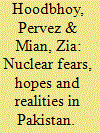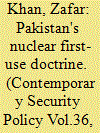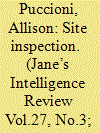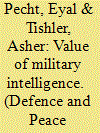|
|
|
Sort Order |
|
|
|
Items / Page
|
|
|
|
|
|
|
| Srl | Item |
| 1 |
ID:
136910


|
|
|
|
|
| Summary/Abstract |
The author looks at the prospects for an active global defence (AGD) to be developed in Russia as a counterweight to the US prompt global strike concept, the role and place of the Land Forces, antiaircraft units in the AGD system, and they key criteria the antiaircraft system has to meet to be effecting in protecting troops and facilities
|
|
|
|
|
|
|
|
|
|
|
|
|
|
|
|
| 2 |
ID:
136370


|
|
|
|
|
| Summary/Abstract |
Sudan’s arms industry is growing and its products can be found across Africa and the Middle East. Emile LeBrun and Jonah Leff examine the dispersal of weapons and ammunition originating from the country across regional combat zones.
|
|
|
|
|
|
|
|
|
|
|
|
|
|
|
|
| 3 |
ID:
134536


|
|
|
|
|
| Summary/Abstract |
After more than three years of corrosive wars, Syria no longer exists as a nation-state. It has been replaced by disparate entities and precarious arrangements – to the detriment of the Syrian population. The ‘Divided States of Syria’ are in large part the result of the survival strategy of the regime, aided by the futile pursuit of a ‘political solution’ by the international community. As the tragedy deepens, the recovery of Syria becomes more difficult, and the implications for regional stability increase in gravity. The West – the United States in particular – has abstained from forceful engagement. Yet, the price to pay today may in retrospect pale in light of the political, strategic and moral catastrophes that the current reserved approach is enabling.
|
|
|
|
|
|
|
|
|
|
|
|
|
|
|
|
| 4 |
ID:
135790


|
|
|
|
|
| Summary/Abstract |
This paper investigates the implications of transitional politics to the processes and outcomes of the disarmament, demobilization and reintegration (DDR) programme targeted to the Maoist ex-combatants in Nepal. It shows that the DDR programme in Nepal was unconventional because of (a) following its own context-specific model developed outside of an established DDR framework, (b) being a process led by national actors in the absence of external intervention, and (c) offering no space for non-state actors such as civil society and business to engage in designing and implementing management of the Maoist arms and armies. Highly politicized by conflicting needs and interests of key political actors, the DDR programme was stalled for nearly six years before a resolution about the future of the ex-combatants was forged. Failure of the political actors to forge a common shared outcome of the DDR programme, lack of clarity in the peace negotiation document in terms of processes of rehabilitation and integration of the ex-combatants, and minimal political will of the Maoist to participate in the DDR programme have been identified as key political constrains that have significantly implicated and altered the modality, function and outcome of the DDR programme in Nepal.
|
|
|
|
|
|
|
|
|
|
|
|
|
|
|
|
| 5 |
ID:
135168


|
|
|
|
|
| Summary/Abstract |
In April 2011, Pakistan declared that it had tested a short-range battlefield nuclear missile, the Nasr.1 Since then, prominent purveyors of Pakistani nuclear doctrine, including Lieutenant General Khalid Kidwai and former diplomat Maleeha Lodhi, have portrayed the Nasr missile as a counter to India’s “Cold Start” war doctrine.2
That doctrine supposedly aims at rapid but limited retaliatory incursions into Pakistan by the Indian army to seize and hold narrow slices of territory in response to a terrorism event in India involving Pakistanis. The rationale is that the seized territory would be returned in exchange for Pakistani extradition of extremists inflicting terrorism onto India. The doctrine is based on the assumption that Pakistan would not resort to the use of nuclear weapons in response to a limited Indian incursion, thereby offering space for conventional conflict even in a nuclearized environment.
Pointing to this Indian war doctrine, Pakistani decision-makers now argue that the deterrent value of their current arsenal operates only at the strategic level. According to this line of reasoning, the gap at the tactical level gives India the freedom to successfully engage in limited Cold Start-style military operations without fear of nuclear escalation. Development of the low-yield, tactical battlefield nuclear weapon, the Nasr missile, is seen as the solution providing “flexible deterrence options”3 for an appropriate response to Cold Start, rather than massive nuclear retaliation against India. Nasr proponents argue that by maintaining “a credible linkage between limited conventional war and nuclear escalation,” the missile will deter India from carrying out its plan.4
This approach might appear to be sensible, but it suffers from two important flaws. First, the Cold Start doctrine has not been actively implemented and therefore does not seem to represent a genuine threat to Pakistan. Second, battlefield nuclear weapons are a key part of the proposed solution, but it may be extremely difficult to establish a command and control system that would effectively preclude the possibility of an accidental or unauthorized launch.
|
|
|
|
|
|
|
|
|
|
|
|
|
|
|
|
| 6 |
ID:
136876


|
|
|
|
|
| Summary/Abstract |
Almost across the board, recent studies of small arms proliferation and policy in Africa seem to have disengaged from historical data and analysis. This article contextualizes current debates on small arms and how they relate to the African continent, by revisiting historical data and analysis. The article draws on the relatively large literature on firearms in African history from the slave trade to early independence to offer new ways of thinking about small arms imports, the impact and prospects for control. Despite the richness of historical studies, they tend to be treated as historical conditions, not assessed for their implications for the current small arms regime. Reflecting on the historical sequence, it appears as if the situation today resembles that of the beginning of the 20th century. Enforcement of local leadership is often weak and the arms trade is relatively large and liberalized. This review finds that historical conditions and structures are built into Africa's current arms control architecture, posing significant challenges for effectiveness and legitimacy. The large scale of old and obsolete small arms frequent in sub-Saharan Africa suggests that weapon destruction programmes, rather than marking, recordkeeping and safe stockpiling of old stocks or recovered weapons, would often be more manageable and offer greater improvements in local security. The positive aspects of external influences on African sub-regional arms control regimes in terms of financial and technical support should be carefully weighed against the risk of reinforcing old patterns.
|
|
|
|
|
|
|
|
|
|
|
|
|
|
|
|
| 7 |
ID:
134487


|
|
|
|
|
| Summary/Abstract |
India's nuclear breakout in 1998, foreshadowed as early as 1974, may have been understandable for reasons of global nuclear politics, a triangular regional equation between China, India and Pakistan, and domestic politics. Yet the utility of India's nuclear weapons remains questionable on many grounds. Nuclear deterrence is dubious in general and especially dubious in the subcontinent. Nuclear weapons are not usable as weapons of compellence or defence. They failed to stop the Pakistani incursion in Kargil in 1999 or the terrorist attack on Mumbai in 2008. They will not help India to shape the military calculations of likely enemies. And India's global status and profile will be determined far more crucially by its economic performance than nuclear weapons. Meanwhile, they do impose direct and opportunity costs economically, risk corrosion of democratic accountability, add to global concerns about nuclear terrorism, and have not helped the cause of global nuclear non-proliferation and disarmament. Because the consequences of a limited regional war involving India could be catastrophic for the world, others have both the right and a responsibility to engage with the issue. For all these reasons, a denuclearized world that includes the destruction of India's nuclear stockpile would favourably affect the balance of India's security and other interests, national and international interests, and material interests and value goals.
|
|
|
|
|
|
|
|
|
|
|
|
|
|
|
|
| 8 |
ID:
136380


|
|
|
|
|
| Summary/Abstract |
Russia’s foreign policy is currently under heavy scrutiny, but Moscow is determined to maintain a credible deterrent missile force Sean O’Connor examines the progress of these upgraded and how they are restricted by the new START missile treaty with the US
|
|
|
|
|
|
|
|
|
|
|
|
|
|
|
|
| 9 |
ID:
136904


|
|
|
|
|
| Summary/Abstract |
The authors offer their interpretation of the term “information weapon” and their own definition of an information weapon non-proliferation regime. By analogy with the establishment and maintenance of the WMD non-proliferation regime, they give their arguments for rules and principles to be followed in structuring and breaking down an information weapon non-proliferation regime into components, where reasonable.
|
|
|
|
|
|
|
|
|
|
|
|
|
|
|
|
| 10 |
ID:
136877


|
|
|
|
|
| Summary/Abstract |
Weapons of Mass Destruction (WMD) is internationally recognized to categorize nuclear, chemical, and biological weapons. Despite their joint categorization, each weapon is distinct from the other and use and possession are treated differently. Previous studies have focused on technological aspects of these weapons, failing to examine and explain the distinct nature and underlying significance of this term. Adopting a constructivist approach, and utilizing sociological research, this work addresses this gap by restoring the underlying strategic and ethical significance of the concept of WMD. The article stresses stigmatization of WMD by the international community. The evolving condemnation of chemical and biological weapons forged the stigma and led to the condemnation of nuclear weapons. WMD have been framed as a threat to humanity due to their ability to create widespread, long-term, irreversible destruction. WMD have also been associated with elevated status and power. These two aspects cannot be separated from each other. The article shows that the actors involved in stigmatization have varied. Initially, the stigma emerged top-down, via government officials. In time, grass roots movements and the general public have also condemned these weapons. Secondly, stigmatizing was driven by perceptions of social, economic, and political power, which elevated the status of these weapons. Stigmatization then developed as a reaction to the threatened possession and use of WMD by antagonistic actors. The ethical and political processes cannot be distinguished from each other; each has formed to frame the image of the long-term danger of WMD. Understanding this process of stigmatization is of particular importance at a time in which the threat from these weapons has increased. This work therefore provides greater insight and understanding into ways to address this challenging subject.
|
|
|
|
|
|
|
|
|
|
|
|
|
|
|
|
| 11 |
ID:
134488


|
|
|
|
|
| Summary/Abstract |
In the four decades since Pakistan launched its nuclear weapons program, and especially in the fifteen years since the nuclear tests of 1998, a way of thinking and a related set of feelings about the bomb have taken hold among policy-makers and the public in Pakistan. These include the ideas that the bomb can ensure Pakistan's security; resolve the long-standing dispute with India over Kashmir in Pakistan's favour; help create a new national spirit; establish Pakistan as a leader among Islamic countries; and usher in a new stage in Pakistan's economic development. None of these hopes has come to pass, and in many ways Pakistan is much worse off than before it went nuclear. Yet the feelings about the bomb remain strong and it is these feelings that will have to be examined critically and be set aside if Pakistan is to move towards nuclear restraint and nuclear disarmament. This will require a measure of stability in a country beset by multiple insurgencies, the emergence of a peace movement able to launch a national debate on foreign policy and nuclear weapons, and greater international concern regarding the outcomes of nuclear arms racing in South Asia.
|
|
|
|
|
|
|
|
|
|
|
|
|
|
|
|
| 12 |
ID:
136879


|
|
|
|
|
| Summary/Abstract |
A close look at the literature on Pakistan's nuclear weapons doctrine reveals the ambiguity in Pakistan's nuclear-use options. Pakistani officials and commentators leave open the possibility that Pakistan would use its nuclear weapon first, but it is not clear when, where, or how it would. Others conclude that Islamabad would use its nuclear weapon only as a last resort, but that condition too remains vague. This article examines the puzzle of Pakistan's nuclear weapons use, demonstrating that ambiguity plays a central role in Pakistan's nuclear weapons policy, much as nuclear ambiguity exists in each nuclear weapons state's policy. This article departs from previous research and commentary on Pakistan's nuclear doctrine by introducing the thesis that Pakistan's nuclear ambiguity is real, but far from internationally unique. Pakistan, like the USA at the onset of the nuclear era, relies on nuclear weapons for survival. The development of Pakistan's forces, including tactical nuclear weapons, suggests an emphasis on counterforce targeting. The role of domestic political processes, the civil–military dilemma and its impact on strategic policy in Pakistan, have received considerable attention, but still require untangling. Progress towards no first use probably requires changes to the conventional balance in South Asia, and stronger democratic, civilian rule in Pakistan, free of direct intervention from the army. Finally, global dynamics shaping the salience of nuclear weapons globally cannot be disregarded in any assessment of South Asian and Pakistani dynamics.
|
|
|
|
|
|
|
|
|
|
|
|
|
|
|
|
| 13 |
ID:
136366


|
|
|
|
|
| Summary/Abstract |
The arms trade treaty has established stricter rules on conventional weapons transfers, but national interest will still come first for many states. Christian Kessler assesses the likehood of the agreement reducing illicit weapons trafficking and human suffering
|
|
|
|
|
|
|
|
|
|
|
|
|
|
|
|
| 14 |
ID:
136856


|
|
|
|
|
| Summary/Abstract |
The ongoing development of North Korea’s missile capability has the potential to bring into question the US’s commitment to its regional allies. In a detailed survey of satellite imagery over North Korea, Allison Puccioni assesses the current state of the threat.
|
|
|
|
|
|
|
|
|
|
|
|
|
|
|
|
| 15 |
ID:
136959


|
|
|
|
|
| Summary/Abstract |
This study evaluates the role of military intelligence in an arms race between two countries. The intelligence apparatus of each country evaluates the rival’s capabilities and intentions, and enhances its military capability by increasing the effectiveness of its own weapon systems and reducing the effectiveness of the rival’s weapon systems. Intelligence superiority also yields an advantage in deterrence and preemption. This study shows the following. (a) Investment in intelligence is much less beneficial for small government budgets, low intelligence efficiency, and a low degree of conservatism on the part of the policy-maker. (b) The expenditure on intelligence increases when intelligence efficiency is low and rising, and decreases when intelligence efficiency is high and rising. (c) Being very conservative may be costly to the country. (d) High-quality human capital substantially improves the country’s security and welfare, particularly when the rivals are engaged in a knowledge race in addition to the usual arms race. An application of the model to the Israeli–Syrian arms race demonstrates its validity and usefulness.
|
|
|
|
|
|
|
|
|
|
|
|
|
|
|
|
| 16 |
ID:
136701


|
|
|
|
|
| Summary/Abstract |
Nuclear weapons will come to loom larger—and perhaps much larger—than they have since the Cold War over U.S. and Chinese military planning.
|
|
|
|
|
|
|
|
|
|
|
|
|
|
|
|
| 17 |
ID:
136878


|
|
|
|
|
| Summary/Abstract |
A new line of nuclear winter research shows that even small, regional nuclear wars could have catastrophic global consequences. However, major disarmament to avoid nuclear winter goes against the reasons nuclear weapon states have for keeping their weapons in the first place, in particular deterrence. To reconcile these conflicting aims, this paper develops the concept of winter-safe deterrence, defined as military force capable of meeting the deterrence goals of today's nuclear weapon states without risking catastrophic nuclear winter. This paper analyses nuclear winter risk, finding a winter-safe limit of about 50 nuclear weapons total worldwide. This paper then evaluates a variety of candidate weapons for winter-safe deterrence. Non-contagious biological weapons (such as anthrax or ricin), neutron bombs detonated at altitude, and nuclear electromagnetic weapons show the most promise. Each weapon has downsides, and the paper's analysis is only tentative, but winter-safe deterrence does appear both feasible and desirable given the urgency of nuclear winter risk.
|
|
|
|
|
|
|
|
|
|
|
|
|
|
|
|
|
|
|
|
|